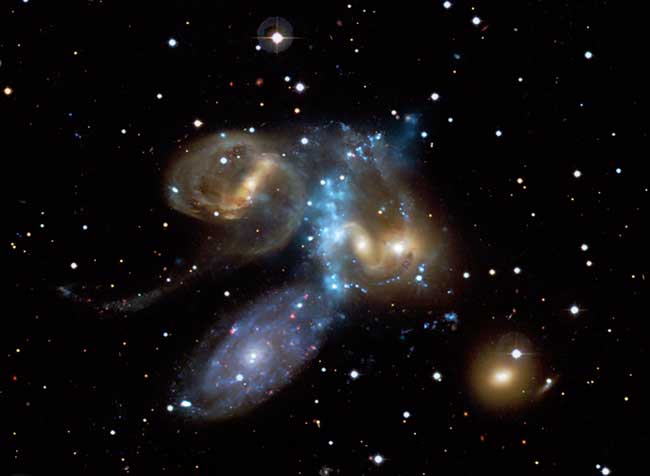New Look at a Colossal Cosmic Collision

A fresh glimpse of a well-known set of colliding galaxies gives scientists a rare opportunity to observe the way the galactic bodies evolve.
A newly released image of Stephan's Quintet, a compact group of galaxies located about 280 million light-years from Earth, shows a system dominated previously by spiral galaxies developing into one made up of elliptical galaxies.
One of the galaxies (NGC 7318b) is hurling through the core at almost 2 million mph (3.2 million kph), generating a shockwave that may be causing the ridge of X-ray emission seen by NASA's Chandra X-ray Observatory.
Astronomers suspect that some of the X-ray emission may have been caused by Supernova explosions, stellar winds and binary systems with massive, disintegrating stars.
Scientists say other signs complex interactions, such as the long tails visible in the image, were likely the result of one or more passages through the galaxy group by NGC 7317.
Breaking space news, the latest updates on rocket launches, skywatching events and more!

Space.com is the premier source of space exploration, innovation and astronomy news, chronicling (and celebrating) humanity's ongoing expansion across the final frontier. Originally founded in 1999, Space.com is, and always has been, the passion of writers and editors who are space fans and also trained journalists. Our current news team consists of Editor-in-Chief Tariq Malik; Editor Hanneke Weitering, Senior Space Writer Mike Wall; Senior Writer Meghan Bartels; Senior Writer Chelsea Gohd, Senior Writer Tereza Pultarova and Staff Writer Alexander Cox, focusing on e-commerce. Senior Producer Steve Spaleta oversees our space videos, with Diana Whitcroft as our Social Media Editor.
